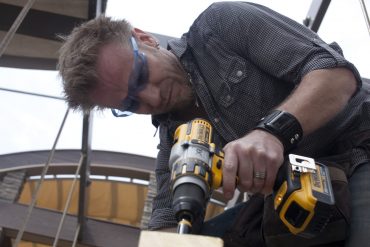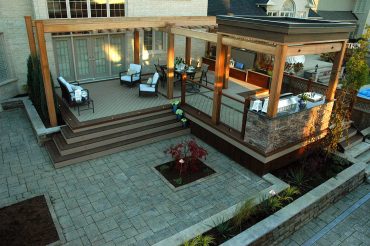
John Bleasby
Design-Build Evolution: Paul Lafrance on the importance of charging for designs
Canadian ContractorGiving your creative ideas for free away is a slippery slope. Being totally upfront about costs provides traction.
Paul and Janna Lafrance make no bones about charging for designs right up front. In fact, the Paul Lafrance Design website goes so far as to outline four different levels of work for both interior and exterior projects, and estimated design and construction budgets for each. With that cleared up, the discussion can then begin in earnest about the scope of work and the elements of construction clients can really afford.
In my final installment of my conversations with Paul and Janna, I ask how and why this works for their business.
Given your talents and personality, Paul, the creative juices must flow as soon as you sit down with a prospect.
Paul: That’s where I have to be careful because I’ve always had a natural rapport with people, and a natural ability to get people to open up to me. It’s a really big honor that people will tell me things and share stories.
However, you make it very clear that you charge for your designs, whether you get the actual contract to build or not.
Paul: That’s where so many small business owners who are doing design-build will lose so much time, because they’re getting your brains picked for nothing. You have to protect yourself from that. People will take advantage of you.
 Janna: And we did do that for a long time. We’d think, “We don’t want to lose the job, so we’ll give it away for free.” You actually end up paying for it. It’s a scary thing to do, to say to a client, “We charge for our designs.” They might say, “But I can get a free design from these other people.” You have to explain why you charge. Even so, you might lose that client. You might lose those clients half the time. But the other half who will pay the design fee are making a commitment and are much more likely to go ahead with the work.
Janna: And we did do that for a long time. We’d think, “We don’t want to lose the job, so we’ll give it away for free.” You actually end up paying for it. It’s a scary thing to do, to say to a client, “We charge for our designs.” They might say, “But I can get a free design from these other people.” You have to explain why you charge. Even so, you might lose that client. You might lose those clients half the time. But the other half who will pay the design fee are making a commitment and are much more likely to go ahead with the work.
You make it very clear on your web site how clients can match their project expectations with your fees and your scope of work by detailing scope-of-work categories.
Paul: You want to make it easy for them. When I go on a web site, I want to find out the cost of something and I want to find out right now. If people have to make a phone call before they even get an idea of cost, in this day and age and given people’s short attention spans, they’ll just go to the next window and move on. I find it such a mistake with so many companies who say, “Call us and we’ll give you a quote.”
But it’s a very bold move. I haven’t seen such defined price categorization right up front on other sites.
Janna: It was trial and error. We had a lot of prospects coming to us with no clue about how much their deck was going to cost, and we were spending hours and hours for nothing. We decided this was something we were going to change.
Paul: The idea of being upfront is surprising to people. You want to be able to answer as many questions as possible before you even talk to them. It serves us hugely because we’re not dealing with tire-kickers.
Does it help avoid those awkward conversations with clients who think it’s the contractor’s fault when a project goes over-budget?
 Paul: You’re always going to have that issue. Say you go to the grocery store with one hundred dollars to spend. If your bill comes to one hundred and twenty, you don’t negotiate with the cashier. They tell you to put some stuff back. In the contracting world, you have to value yourself as a designer and as a builder. You can’t be afraid of losing a job. I learned to fire clients before I hired them. It’s a very important thing to learn how to do, because one of the things about being upfront is being able to say, “This is the price.” Back in the day, I was so excited about creating stuff, and everything being trial and error, the artist in me would have bankrupted us if I didn’t have Janna looking at the profit and loss and saying, “Honey, about that waterfall you created for them?” And I’d say, “I knew they couldn’t afford it but I had to build it.” That’s how you learn from mistakes.
Paul: You’re always going to have that issue. Say you go to the grocery store with one hundred dollars to spend. If your bill comes to one hundred and twenty, you don’t negotiate with the cashier. They tell you to put some stuff back. In the contracting world, you have to value yourself as a designer and as a builder. You can’t be afraid of losing a job. I learned to fire clients before I hired them. It’s a very important thing to learn how to do, because one of the things about being upfront is being able to say, “This is the price.” Back in the day, I was so excited about creating stuff, and everything being trial and error, the artist in me would have bankrupted us if I didn’t have Janna looking at the profit and loss and saying, “Honey, about that waterfall you created for them?” And I’d say, “I knew they couldn’t afford it but I had to build it.” That’s how you learn from mistakes.
Also Read….
What is Design-Build?
Kate Campbell makes Design/Build a priority
Bringing design services in-house paid off for Toronto contractor ‘Men at Work’
Follow John on Instagram and on Twitter for notifications about our newest posts 
Advertisement
Print this page


I completely agree with this. There is a huge difference between concepts / designs and quoting. When potential clients ask if I provide free quotes, my response is yes. But I immediately make them aware that they need to have something to quote from, and explain that the design required to quote from comes with a cost. I find this a great way to differentiate the tire kickers from those who are serious about getting a project done. I’m glad to see this focus on design – build firms. In my experience, a design – build firm provides a huge benefit to the client because one firm is involved from concept to completion. This reduces the amount of “communication translation error” – meaning a discussion with the designer can include the constructor, at the same meeting. This helps everyone involved see the intent of the overall project, right from the outset. Having the designer and constructor work side by side also helps eliminate issues throughout the project. A designer may want to achieve a certain effect that may not be possible due to structural issues (more so in renovations than new builds) and solutions are a lot easier to achieve in the planning stage than after a month or two of construction
Awesome article! The majority of our jobs incorporate unique design and innovation so developing design build propositions happened quite naturally but it’s only been recently that we’ve begun to recognize it’s bigger potential. Design build has a tremendous impact and value throughout the entire project and that’s big a motivator for us as we plan for the future.
Biggest “that’s me” laugh: “I knew they couldn’t afford it but I had to build it.”
Biggest take away: “I find it such a mistake with so many companies who say, “Call us and we’ll give you a quote.””
Thanks for a great read!